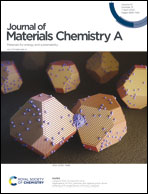Visible-light photocatalytic hydrogen production in a narrow-bandgap semiconducting La/Ni-modified KNbO3 ferroelectric and further enhancement via high-field poling†
Abstract
Compared with traditional wide-bandgap oxide ferroelectrics that exhibit excellent UV photocatalysis, narrow-bandgap semiconducting ferroelectrics demonstrate broad application prospects in the field of visible-light photocatalysis. However, due to significant current leakage and weakening of ferroelectricity in most semiconducting ferroelectrics, establishing high-field poling via an external electric field to boost photocatalytic activity further is difficult. Therefore, balancing the semiconductivity and ferroelectricity of such materials is challenging. Here, a novel visible-light-driven semiconducting ferroelectric photocatalyst of La/Ni-modified KNbO3, namely, (1 − x) KNbO3–xLaNiO3−δ with x = 0.00–0.04, is successfully prepared via sintering. Similar to traditional wide-bandgap KNbO3 ferroelectrics, semiconducting ferroelectrics also manifest an excellent photocatalytic hydrogen evolution (PHE) rate under simulated sunlight (1169.7 µmol g−1 h−1). The 0.99KNbO3–0.01LaNiO3−δ composition can exhibit visible-light PHE activity (40.1 µmol g−1 h−1). Moreover, semiconducting ferroelectrics at room temperature can still be poled under a high external electric field, and the visible PHE rate of 0.99KNbO3–0.01LaNiO3−δ can be increased by 16 times (642.0 µmol g−1 h−1) via high-field poling. This remarkable visible PHE rate observed in the modified system is associated with the very narrow bandgap of 1.45–1.24 eV and the enhancement of carrier separation efficiency by high-field poling. This work provides a feasible solution for designing ferroelectric-based oxide photocatalysts with excellent visible-light activity and insights into the polarisation mechanisms of semiconducting ferroelectrics.



 Please wait while we load your content...
Please wait while we load your content...